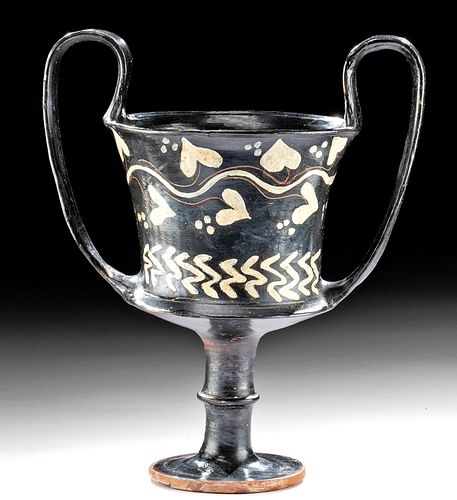Greek Boeotian Black Glazed Kantharos - Ivy Motif
Lot 23a
About Seller
Artemis Gallery
686 S Taylor Ave, Ste 106
Louisville, CO 80027
United States
Selling antiquities, ancient and ethnographic art online since 1993, Artemis Gallery specializes in Classical Antiquities (Egyptian, Greek, Roman, Near Eastern), Asian, Pre-Columbian, African / Tribal / Oceanographic art. Our extensive inventory includes pottery, stone, metal, wood, glass and textil...Read more
Categories
Estimate:
$3,000 - $6,000
Absentee vs Live bid
Two ways to bid:
- Leave a max absentee bid and the platform will bid on your behalf up to your maximum bid during the live auction.
- Bid live during the auction and your bids will be submitted real-time to the auctioneer.
Bid Increments
| Price | Bid Increment |
|---|---|
| $0 | $25 |
| $300 | $50 |
| $1,000 | $100 |
| $2,000 | $250 |
| $5,000 | $500 |
| $10,000 | $1,000 |
| $20,000 | $2,500 |
| $50,000 | $5,000 |
| $100,000 | $10,000 |
| $200,000 | $20,000 |
About Auction
By Artemis Gallery
Feb 13, 2020
Set Reminder
2020-02-13 10:00:00
2020-02-13 10:00:00
America/New_York
Bidsquare
Bidsquare : Exceptional Antiquities, Asian, Ethnographic
https://www.bidsquare.com/auctions/artemis-gallery/exceptional-antiquities-asian-ethnographic-4848
An important one-day auction featuring museum-worthy examples of Egyptian, Greek, Roman, Etruscan, Near Eastern, Far East / Asian, Pre-Columbian, African / Tribal, Oceanic, Native American, Spanish Colonial, Russian, Fossils, Ancient Jewelry, Fine Art, so much more! Artemis Gallery info@artemisgallery.com
An important one-day auction featuring museum-worthy examples of Egyptian, Greek, Roman, Etruscan, Near Eastern, Far East / Asian, Pre-Columbian, African / Tribal, Oceanic, Native American, Spanish Colonial, Russian, Fossils, Ancient Jewelry, Fine Art, so much more! Artemis Gallery info@artemisgallery.com
- Lot Description
Ancient Greece, Boeotia, ca. 450 to 425 BCE. A large Boeotian Greek black glazed kantharos (wine cup) with high attenuated twin handles and a high stemmed foot. The body is decorated with fugitive (added) white pigment to render a beautiful ivy garland embellished with trios of dots to represent berries as well as a band of zigzag geometric motifs below. Nice incised markings accentuate the sinuous vines. Lovely hints of iridescence to the black glaze throughout. Size: 8.25" W handlespan x 9.75" H (21 cm x 24.8 cm)
The Etruscans in Italy produced bucchero kantharoi in the late 7th or early 6th century BCE and the shape was later adopted by Boeotian potters. The kantharos is a cup used to hold wine, possibly for drinking or for ritual use or offerings. The kantharos was also an attribute of Dionysus (Roman Bacchus), the god of wine who is oftentimes depicted holding this type of vessel. Satyrs, bestial goat-men associated with Dionysus, and Maenads, women who joined in the revelry of Dionysian festivals, were also commonly portrayed on painted pottery holding a kantharos.
A similar example may be found in the Louvre Museum, inv. no. MNC 670, bearing a dedication in the Boeotian alphabet, from Thespiae.
Provenance: private East Coast, USA collection; ex-La Reine Margot, Paris, France, acquired in the 1990s
All items legal to buy/sell under U.S. Statute covering cultural patrimony Code 2600, CHAPTER 14, and are guaranteed to be as described or your money back.
A Certificate of Authenticity will accompany all winning bids.
We ship worldwide and handle all shipping in-house for your convenience.
#152841Professionally repaired from multiple pieces with restoration over the break lines. Possible touch up to added white pigment. Beautiful areas of silvery iridescence to areas of the black glazeCondition
- Shipping Info
-
All shipping is handled in-house for your convenience. Your invoice from Artemis Gallery will include shipping calculation instructions. If in doubt, please inquire BEFORE bidding for estimated shipping costs for individual items.
-
- Buyer's Premium



 EUR
EUR CAD
CAD AUD
AUD GBP
GBP MXN
MXN HKD
HKD CNY
CNY MYR
MYR SEK
SEK SGD
SGD CHF
CHF THB
THB
















